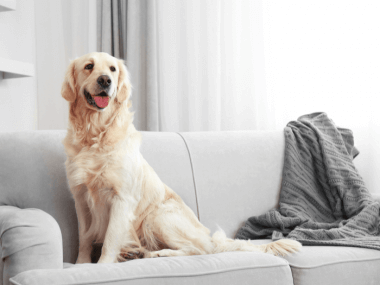How to Keep Dogs Off Furniture
Many dogs like to rest on their humans’ furniture. How do you keep them from making your couch their favorite spot?
Okay, how many of you have come home from work to find your dog sprawled out on the living room sofa like Uncle Bob on Super Bowl Sunday, only with more hair? Yes, I thought so. This week: dogs on furniture and what to do about them.
Buy Now

Dogs Like Your Furniture Because It’s Comfortable

Should Dogs be Allowed on the Furniture?
As you may already have guessed, if you don’t mind your dogs hanging out on your furniture or sleeping in bed with you, I don’t mind either. In our house the dogs (and cats) have an array of floor pillows and sometimes choose to rest there, sometimes on a couch or chair. I do lament the animal hair from time to time, and there’s someone living here who labors under the delusion that a weight of 75 pounds is compatible with holding the job of lapdog, but on the whole our household is content.
When Is It Not Okay for Dogs to Get on the Furniture?
So when is it not okay for dogs to rest on the human furniture at will? I would say there are three such situations. First and most serious is location guarding, a form of resource guarding. If your dog stiffens or curls her lip or growls or snaps at you when you approach her while she lounges on the sofa, then she should forfeit access to the sofa. After you have worked with a competent specialist to modify her behavior, you can consider relaxing the ban. But probably you will always want to make access to the furniture contingent on your permission.
How Do You Keep Your Dog Off the Furniture
Second, maybe you just plain don’t feel like letting the dog on the furniture. Fine! It’s your furniture, and if you don’t want to share with the hairy and odorous, that’s your prerogative. Just bear in mind that a dog who has her own comfy sleep spot will be much likelier to stay off the wingbacks than was my tile-floor client’s well-chilled Maltese. Increase the dog bed’s magnetic quality by occasionally, unpredictably delivering a tasty treat while Dogalini is resting there.
It also helps to make the furniture inaccessible while your dog gets used to sleeping on her own bed. You can put boxes or upside-down chairs on the sofa. Pet supply vendors also offer furniture mats that resemble small versions of the plastic pads used on carpet under office chairs. The blunt spikes detract from your sofa’s cushiony appeal.
I don’t recommend shock mats or booby traps. Provide a supercomfy bed and make the furniture less competitive; there’s no call to frighten or hurt your dog.
Use Access to Furniture as a Reward for Polite Behavior
A third reason for making the furniture off limits, at least without your express okay, is if your dog could use more structure than the average bear. Newly adopted dogs are a prime example. We all know how much easier it is to navigate an unfamiliar social situation when we don’t have to guess about the rules. You can help a new dog settle in by providing a reward-based rule structure from day one. Sitting politely, for instance, gets the dinner bowl placed on the floor. Sitting politely when the human picks up the leash encourages said human to attach leash to collar and head out for a walk. And lying down politely when the human settles in to watch TV might, just might, induce the human to pat the cushion next to her in an inviting way.
Notice that the point here isn’t to withhold anything from your new dog, but rather to teach her that goodies, including furniture access, come in exchange for quiet, polite behavior. You become a trustworthy and consistent source of the things she needs and wants, thus building her confidence in you. Because you deliver only in exchange for behaviors that you like, your dog offers those behaviors more and more.
Structure like this works well for puppies, rowdy dogs, and pushy, noodgy dogs too. Access to the furniture has no magical significance–it’s just one of the many desirables, like food and walkies, that you have in your keeping. Leverage it to shape nice manners. Or, of course, if you prefer to hand out goodies in exchange for rowdy, out-of-control behavior, be my guest. Or maybe someone else’s.
Teach Your Dog to Move Over or Get Off the Furniture on Cue
It’s convenient to teach your sofa-loving dog to move out of the way or get off entirely when you ask him to. Targeting–moving to touch your hand or another object–is an easy skill that’s perfect for the purpose. And here’s my lazy way to teach Dogalini to hit the floor. Pick a cue word–“Floor!,” maybe?–and have a delicious treat ready. As always, it helps to start with a slightly hungry dog. Say your cue, wait one second, then toss a single treat on the floor with a sweeping gesture so that Dogalini watches it and sees the treat land. When she gets off the furniture, she gets the treat. Follow up with another activity, or sit down in the vacated spot, so Dogalini doesn’t immediately jump back up.
[[AdMiddle]
Over several days, try to find a dozen or so opportunities to practice this exercise. Then, on the next rep, say your cue, wait, and gesture as if you were tossing the treat, but don’t actually toss it. Instead, when Dogalini gets off the sofa, deliver the treat from your other hand or from a stash in another location. After a dozen more reps like that, you can begin to give treats less often. Sometimes Dogalini gets a food treat and praise for jumping off the furniture, and sometimes she just gets praise. Over time, gradually decrease the frequency of food treats. Don’t eliminate them entirely–let Dogalini have a nice surprise once in a while. That will keep her response strong as she guesses that maybe this time she’ll get lucky.
Here’s wishing you all many enjoyable naps. Your feedback and questions help me prepare future episodes. Email dogtrainer@quickanddirtytips.comcreate new email, or visit me on Facebook. My phone number is 206-600-5661. And that’s all for this week!
Dog on Couch image from Shutterstock







